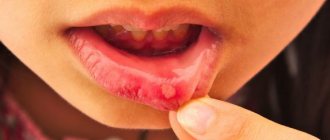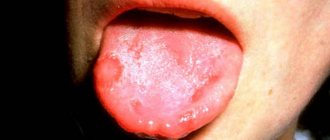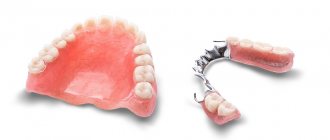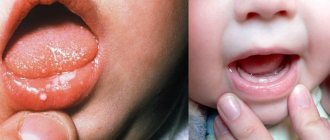Causes
Herpetic stomatitis, or as it is also called aphthous stomatitis, is dangerous, first of all, for young children. It is a serious viral disease, which, in addition to damaging the oral mucosa, causes general intoxication of the body and provokes malfunctions of the nervous, immune, and reticuloendothelial systems.
Herpes, which is the causative agent of the disease, may not make itself felt for a long time, although infection usually occurs in early childhood.
When the baby’s immunity is weakened, the herpes virus is activated and begins to multiply, causing an increase in temperature, enlargement of the submandibular lymph nodes, acute inflammation of the mucous membrane, and the formation of bleeding and painful ulcers on its surface.
Main reasons:
- decreased baby's immunity;
- previous infectious diseases;
- lack of vitamins;
- insufficient oral hygiene;
- direct contact with patients with herpes stomatitis.
Infants are more likely to become infected with the herpes virus during childbirth, provided the mother has a herpes infection. In children under one year old and school-age children, the virus is activated against the background of an organism weakened by disease and vitamin deficiency.
Types of disease
Stomatitis has different forms, depending on which the doctor determines whether it is contagious or not, and also prescribes appropriate treatment.
Allergic stomatitis
This is a common form of the disease that is difficult to treat. From the name it is clear that the cause of its development is an allergy, but it is necessary to find out what exactly it is. These could be medications, food, materials used for prosthetics. The disease is accompanied by the appearance of ulcers, which provoke pain.
Viral stomatitis
The most common type of viral stomatitis is herpetic stomatitis, the causative agent of which is the herpes virus. There are other forms that are provoked by adenovirus, enterovirus, etc. They are often found in children under 5–6 years of age, but are also common among older age groups. A feature of viral stomatitis is its erosive spread, when one ulcer appears next to another. Herpes mucositis may cause complications such as fever, nausea, vomiting and diarrhea.
This form of the disease is transmitted to others by contact and airborne droplets. If it is diagnosed, for example, in someone in kindergarten, then quarantine must be introduced. Infection occurs through dishes and toys, so the disease can quickly spread from child to child.
The virus spreads from nursing mothers to children if hygiene rules are violated. Adults become infected even through handshakes. Sneezing also causes the disease to develop.
Aphthous stomatitis
This form is common among adults. It develops against the background of a weakening of the body’s immune forces, so aphthous stomatitis is a common occurrence in spring and autumn. With this type of disease, characteristic aphthae appear - small ulcers. They can be single or group. Aphthous mucositis is not spread from person to person.
Fungal stomatitis
The disease manifests itself in children and adults, mainly in infants and women. It is provoked by fungi of the genus Candida, which are activated in the oral cavity when the immune system is weakened. The cause of fungal stomatitis can be long-term use of antibiotics. In addition to ulcers, its characteristic feature is a cheesy coating on the tongue, palate and inner surface of the cheeks.
Bacterial stomatitis
This type of disease is diagnosed when the oral cavity is affected by microorganisms, most often streptococci, staphylococci. The manifestation of bacterial stomatitis is provoked by tuberculosis, as well as sexually transmitted diseases, for example, gonorrhea, syphilis. More often, children whose immunity is not strong enough suffer from it. But everyone must be careful. The disease is transmitted from children to adults through dishes, toys, and damage to the mucous membrane.
This form is characterized by swelling in the oral cavity, redness of the mucous membrane and hardening of the palate, as well as an unpleasant odor, ulceration and cracks. Symptoms of intoxication may appear: vomiting, weakness, rapid pulse.
Other forms of stomatitis
In addition to the above types of disease, the following can also be distinguished:
- chemical stomatitis - occurs as a result of burns to the oral cavity with alkaline substances or acid;
- traumatic - ulcers are formed as a result of impact and disruption of tissue integrity;
- radiation – develops as a result of radiation.
Such forms are non-contagious and therefore do not pose a danger to other people.
Main symptoms and signs of the disease
Acute herpetic stomatitis in children develops gradually and is preceded by an incubation period lasting from two days to 3 weeks.
Early symptoms of the disease are:
- burning in the mouth;
- increased salivation;
- headache, nausea, general weakness;
- increased body temperature;
- enlargement of the submandibular lymph nodes;
- the appearance of bad breath.
«
If the parents do not respond to the first signs, after a few days the mucous membrane becomes covered with multiple rashes. Small painful blisters itch, respond with acute pain to the touch, and when they rupture, a cloudy liquid flows out of them. The rash appears on the baby’s gums, cheeks, tongue, lips, and wings of the nose.
Herpes stomatitis can affect not only a school-age child, but also an infant.
The mild form of the disease can be easily treated at home; in moderate and severe forms, hospitalization of the small patient is indicated.
Symptoms of herpetic stomatitis during exacerbation
With exacerbation of stomatitis, signs of general malaise and intoxication may appear: headache, muscle weakness, high temperature. The main symptoms of the disease occur in the oral cavity:
- the mucous membrane becomes red and inflamed;
- bubbles appear in groups on the red border of the lips, the cheek side, on the gums and tongue;
- after 2-3 days from the onset of the disease, the vesicles open with the formation of erosions covered with fibrinous plaque;
- pain appears, intensifying while chewing food;
- drooling and enlarged cervical lymph nodes may occur;
- the mucous membrane heals in 5-10 days, leaving no scars.
You can see what chronic herpetic stomatitis looks like in the photo - treatment quickly reduces signs of inflammation and leads to the healing of ulcers, but you need to fight first of all with the herpes virus, which regularly worsens against the background of decreased immunity, stress and hypothermia.
Classification and diagnosis
Herpetic stomatitis is classified both according to the severity of the disease and the characteristics of its course.
According to the characteristics of the course, acute and chronic (recurrent) forms are distinguished. Acute stomatitis is characterized by a sudden onset, pronounced symptoms, and rapid development. Without proper treatment, it quickly becomes chronic and can drag on for years, periodically exacerbating.
Based on the degree of severity, there are mild, moderate, and severe forms.
In mild forms, the following are noted:
- slight increase in body temperature;
- redness, swelling, inflammation of the gums;
- swollen lymph nodes;
- a small number of painful ulcers.
The average degree is characterized by:
- significant increase in body temperature;
- general weakness, nausea, headache;
- inflammation of the oral mucosa;
- the appearance of a blistering rash on the inner surface of the cheeks, gums, tongue, and around the mouth.
The severe form causes:
- temperature rise to a critical level;
- lymphadenitis of the cervical, submandibular lymph nodes;
- a sharp disturbance in general well-being;
- the appearance of severe muscle pain, headache;
- nausea, vomiting;
- multiple rashes that spread to the eyelids, conjunctiva, and perioral area.
Diagnosing the disease is not difficult for an experienced doctor. It is based on an analysis of the main symptoms, the order of clinical manifestations of the disease, the nature, and multiplicity of ulcers.
It is necessary to differentiate herpetic stomatitis from viral stomatitis; for this, in the first few days of the disease, a cytological examination of scrapings from erosions and aphthae should be done.
Content:
- The danger of herpetic stomatitis
- Causes of the disease
- Manifestation of herpetic stomatitis
- Diagnosis of the disease
- Treatment of herpetic stomatitis
The danger of herpetic stomatitis
Herpetic stomatitis is an inflammatory disease of the oral mucosa, which is caused by a well-known infectious agent - the herpes virus. Simple forms of inflammation cause discomfort, but do not threaten the patient. However, there are situations when the disease becomes severe: in addition to pronounced ulcerative-necrotic inflammation of the oral epithelium, the respiratory tract, vascular wall, and even internal organs can be involved in the process. You need to know the manifestations of this disease in order to consult a specialist in time, carry out treatment, prevent repeated episodes of herpetic stomatitis (since infection with the herpes virus is accompanied by its lifelong presence in the body) and prevent possible complications.
Causes of the disease
The etiological factor causing stomatitis in this case is herpes simplex virus type 1. There are also HSV - type 2, the so-called “genital herpes”. It is transmitted only sexually and causes damage to the mucous membranes of the genital organs; in this case, there is no herpetic lesion of the oral cavity. The mechanism of transmission of herpes simplex virus type 1 is carried out mainly by contact, much less often by aerosol. Infection occurs at an early age. The first episode of stomatitis is most often observed in childhood. This is primarily due to the fact that by the first year of life the child’s immune protection received from the mother weakens. Childhood is the main risk factor for developing the disease. In some cases, infection is not accompanied by any symptoms, and the child becomes a carrier of the virus. In this case, the disease can manifest itself at any age. For the development of the disease, predisposing factors are also necessary: a decrease in the body's defenses - hypothermia, stressful situations, hormonal disorders, exacerbation of chronic diseases. The herpes virus refers to microorganisms that have tropism (the ability to interact with certain tissues) for epithelium and nervous tissue. In this regard, the lesions will be localized on the mucous membranes and in the nerve formations of the body. Penetrating into cells, the virus begins to multiply and eventually spread throughout the body. Depending on the magnitude of the viral load, the disease will manifest itself at the time of infection or only after sufficient accumulation and reactivation.
Manifestation of herpetic stomatitis
Herpetic stomatitis as one of the forms of the disease occurs more often than others. The clinical picture is specific and allows, in most cases, to promptly recognize the disease and begin treatment. From the onset of symptoms to complete recovery, it can take from 3-5 days to several weeks. Most often, stomatitis begins with an increase in temperature to subfebrile levels. There may be mild symptoms of ARVI - redness of the mucous membrane of the nose, pharynx, tonsils. Lymph nodes can be involved in the process if the body overreacts to the introduction of the virus - most often this happens during the first episode of herpetic stomatitis. Lymph nodes in the head and neck area enlarge and become painful on palpation. The main morphological element of herpetic inflammation is the vesicle (vesicle). A vesicle appears on an inflamed reddish area of the mucous membrane of the lips, gums, cheeks or other area; it can be represented by a single element or multiple vesicles. During its development, the blister gradually increases (on average 2 mm, maybe up to 5 mm), bursts, and in its place an ulcer - aphthae - forms. Herpetic elements in the oral cavity and any other location are very painful. Sometimes there is severe salivation. In the case of moderate and severe cases, other organs are also involved, body temperature rises to 39-40 degrees, signs of intoxication are expressed - myalgia, arthralgia, nausea, vomiting, diarrhea, severe weakness. A lot of vesicles appear; after rupture, they turn into deep ulcers and become necrotic.
Diagnosis of the disease
If you suspect a herpetic lesion of the oral mucosa, you should consult a dentist. In some cases, a consultation with a general practitioner and a dermatovenerologist may be indicated.
Diagnosis is not difficult: collection of complaints and examination makes it possible to make a correct diagnosis at an early stage. In diagnostically unclear cases, methods of special diagnosis of the pathogen may be prescribed - it is detected in scrapings from the mucous membrane (virological diagnosis is difficult), an increase in the titer of antibodies in the blood (a more effective method), PCR diagnostics, and others.
Treatment of herpetic stomatitis
Treatment can be symptomatic - treatment of the oral cavity with solutions: hydrogen peroxide 3%, potassium permanganate 1:10000, furatsilin; it is possible to prescribe painkillers. Etiological treatment is prescribed when the diagnosis of herpes is confirmed. Specific antiviral drugs are used that act on the pathogen - Acyclovir, Valciclovir, Famciclovir. There are forms for local treatment in the form of ointments, as well as tablet and soluble preparations. In simple forms, antiviral drugs are applied only to the affected areas.
How long does the disease last and how many days is the child contagious?
Depending on the complexity of the form, herpes stomatitis in children lasts from several days to 2-3 weeks. With a mild form, the main symptoms disappear on the third or fourth day, treatment of a moderate form takes one to two weeks. The severe form is the most dangerous; healing lasts for weeks and requires mandatory hospitalization of the baby.
The disease is characterized by a high degree of contagiousness precisely during the period of exacerbation.
The infection is transmitted by airborne droplets (including through kissing), when using shared dishes, cutlery, toys, and hygiene items.
Herpes is contagious and can easily be transferred to healthy parts of your own body.
It is necessary to wash your hands thoroughly after treating the surface affected by the sores with medications to prevent the spread of the virus.
How and with what to treat herpetic stomatitis in children
As Dr. Komarovsky notes, treatment of herpetic stomatitis in children, regardless of age, depends on the severity of the disease, the general condition of the patient’s immune system, and the presence or absence of concomitant diseases.
The main question that interests young parents is which doctor should they contact if they suspect herpetic stomatitis. Both a qualified pediatrician and a dentist can advise the child.
Therapeutic methods include both general and local treatment. Common activities include:
- prescription of antiviral drugs (acyclovir, Zovirax, Herpevir, Virolex);
- taking antipyretic and painkillers (paracetamol, Panadol, Eferalgan, Tylenol);
- prescription of antihistamines (diazolin, claritin, erius, fenistil);
- correction of the immune system (immudon, sodium nucleinate);
- vitamin therapy (vitamin C, ascorutin, multivitamins, B vitamins).
Children of older preschool and school age are recommended to be treated with broad-spectrum antibiotics to avoid possible complications.
For newborns and infants, antibiotic therapy is prescribed only as a last resort, with preference given to local therapy:
- applications of painkillers (solution of lidocaine, trimecaine, pyromecaine);
- treating the baby’s oral cavity with antiseptics (solutions of furatsilin, potassium permanganate, brilliant green, blue);
- Treatment of aphthae with iodine should be avoided, as it causes a burn to the mucous membrane;
- the use of antiviral medications in the form of ointments, lotions, solutions (interferon, acyclovir);
- applying an oil solution of vitamin A, sea buckthorn or rosehip oil, solcoseryl to the mucous membrane of the baby’s mouth).
If the symptoms of the disease do not disappear on the 3-4th day of treatment, but only intensify, the child is indicated for treatment in a hospital setting, otherwise stomatitis will become chronic, from which it is impossible to get rid of it.
Herpetic stomatitis: treatment
When stomatitis worsens in adults, treatment at home is commonplace. Usually people limit themselves to local remedies, without using high-quality antiviral drugs, the action of which is aimed specifically at the herpes virus. As a result, the symptoms only subside; the virus itself can continue to multiply in internal organs and tissues, periodically causing relapses.
Therefore, treatment of stomatitis in adults, and especially in children, should be carried out by a qualified specialist. The herpes virus must be detected using modern diagnostic methods to ensure the correct diagnosis.
Treatment of the disease should be comprehensive, including the use of the following groups of drugs:
- antiviral drugs in tablets (Famvir, Acyclovir);
- antipyretic drugs (at high temperatures);
- immunostimulants;
- antiseptics in solutions for treating the oral cavity;
- vitamin complexes that support the body and increase overall tone;
- local agents that have analgesic, anti-inflammatory, regenerating effects.
In uncomplicated cases, herpetic stomatitis is treated at home. Hospitalization may be necessary for a child in the first years of life (with severe fever, intoxication and complications). At high temperatures, antipyretics are prescribed. It is recommended to drink plenty of fluids, food should not irritate the mucous membranes, be moderately warm and preferably pureed. It is necessary to increase the amount of natural foods rich in vitamins in the diet. For weakness and underweight, a high-calorie diet is recommended. Stomatitis is not treated with antibiotics (unless complications arise).
Due to the high contagiousness of the herpes virus, the patient must be provided with separate hygiene items and utensils for eating. Local treatment includes regular treatment of the oral cavity with antiseptic solutions, the use of antiviral ointments and gels. For herpetic stomatitis, specialists prescribe physiotherapeutic procedures (UFO). General strengthening agents and vitamin therapy can increase the body's resistance to infections and reduce the frequency of relapses.
Antiviral drugs are especially effective in the first days of exacerbation of herpetic stomatitis. Depending on the specific remedy, they can be prescribed for 1-7 days. The more effective an antiviral drug is, the more expensive it usually costs.
But if predisposing factors are not excluded, stomatitis will often recur. By paying attention to prevention and general strengthening procedures, you can take control of the disease and significantly improve the quality of life, achieving a reduction in relapses to 1-2 times a year or long-term remission.
Treatment with folk remedies at home
When treating herpes stomatitis in children, it is extremely important to prevent the development of complications and transition to a chronic form. Therefore, all folk remedies are auxiliary in nature and should not replace full treatment.
To strengthen the child's immunity, a decoction of echinacea leaves, ginseng root, and rose hips is well suited.
Rinsing will help relieve itching, burning and pain. For these purposes, you can use decoctions of chamomile flowers, sage, calendula inflorescences, St. John's wort, alder cones, rose petals, and oak bark.
The healing of ulcers and aphthae is facilitated by treating their surface with brilliant green, blue and iodine; they have a drying effect. An alcohol solution of propolis helps well, it relieves the inflammatory process and has an analgesic effect on the oral mucosa. Use with caution to treat small children.
Newborns and infants are recommended to lubricate the inflamed oral mucosa with natural honey. This should be done with extreme caution, since honey is a fairly strong allergen.
Possible complications
Primary infection with herpetic stomatitis is highly treatable. Within 7-10 days, with proper treatment, the child can fully recover. Without appropriate drug therapy, the following complications may develop:
- herpetic keratoconjunctivitis (a dangerous herpetic eye infection that leads to blindness);
- dehydration (due to refusal to eat and drink).
To avoid undesirable consequences, it is necessary to consult a doctor at the first symptoms of the disease, strictly adhere to all instructions, give the baby plenty of fluids, monitor oral hygiene, and wash your hands after each treatment of a surface affected by herpes.
Prevention in children
Preventing infection with the herpes virus is extremely difficult, since 90% of the population are carriers of it. It is important to delay infection as much as possible; the younger the child, the more difficult the disease is to tolerate. It is necessary to avoid contact with people who have an acute herpes virus. From infancy, the baby should be taught to use personal hygiene products, not allowed to drink from someone else’s mug after someone else, or to use used spoons, forks, and plates. You should not kiss someone who has a herpetic sore on their lips.
To prevent herpetic stomatitis, you need to do general strengthening of the child’s immune system, systematically give him B vitamins, multivitamin complexes, and carry out hardening procedures.











